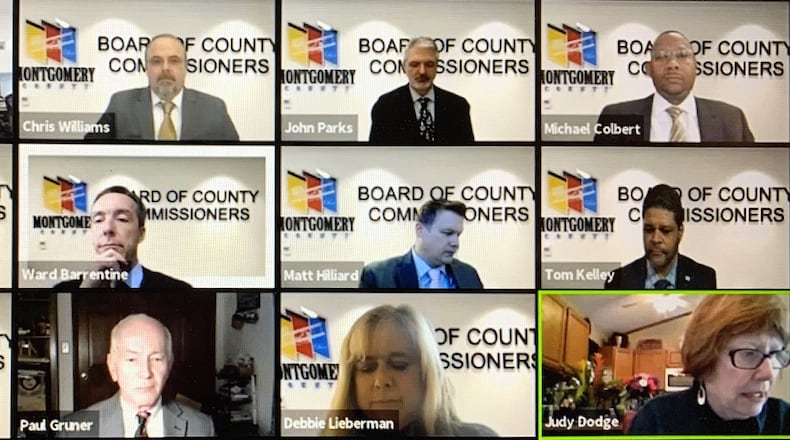“The more the public understands how local government works, the better,” said Montgomery County Commission President Judy Dodge.
As many as 45 people watched Montgomery County Commission meetings on the county’s Facebook page, more than the handful who typically showed up for meetings before the pandemic, according to Dodge.
Had the pandemic not upended in-person meetings last year, Montgomery County commissioners would likely have continued “business as usual” at the Montgomery County Administration Building without “realizing how important accessibility is to our community,” Dodge said.
While members of a public body must be present to be counted in the quorum and to vote, many public boards are expected to continue livestreaming meetings to make them more widely available to the public, said Brodi Conover, an attorney in Bricker and Eckler’s Lebanon office who counsels area municipalities on open meetings law.
Conover said only a handful of the firm’s clients streamed meetings before COVID-19 arrived, but “everyone’s hand was forced.”
During the pandemic, nearly all the firm’s village, township, city and school district clients across the state were holding virtual meetings — often with new equipment and online meeting platform subscriptions purchased with federal COVID relief money.
“I would expect a significant number of municipalities and local government to continue that just because the resources and the ability to do it is already there,” said Conover, who counsels both the cities of Franklin and Middletown.
Prior to the pandemic, the Xenia Board of Education was not streaming meetings. But when in-person meetings resumed this week, the livestream was kept running and will be for the foreseeable future, said Xenia Community Schools Superintendent Gabriel Lofton.
“The decision to continue making board meetings available online was based on several factors, including higher public attendance and participation,” Lofton said. “While this trend may have been due in part to the heightened interest in policy and procedure during COVID, we are happy to see members of our community become more engaged in the process.”
The Ohio General Assembly responded to the COVID-19 outbreak in the spring of 2020 by making changes in the state’s open meetings rules that allowed public bodies to conduct meetings and hearings electronically provided proper public notice was given and public access granted.
But not every public board had the desire — nor the means — to meet virtually, said Ed Huff Jr., a trustee in Darke County’s Brown Twp.
“We chose not to do it because we are in a rural area and we had to keep it open,” he said. “We still had our meetings and wore masks.”
The cost of equipment to stream video is also out of reach for Brown Twp. on its limited $380,000 budget, said Huff, also the first vice president of the Ohio Township Association that serves the state’s 1,308 townships.
Huff said many Ohioans, particularly those living outside high-population areas, lack the high-speed internet needed to view streaming video.
More than 300,000 households representing about 1 million Ohioans lack an internet connection at speeds needed to reliably stream video meetings, according to InnovateOhio.
Though the temporary rule changes were extended to the end of June, some boards went back to in-person meetings earlier, including the Dayton Public Schools Board of Education and elected officials in Beavercreek, Greene County and Miamisburg.
The Ohio Elections Commission holds its next meeting tomorrow back in person. While the meeting will be streamed on the commission’s website, anyone who wants to address the board will have to haul themselves to a 19th floor Riffe Center meeting room in Columbus, according to the meeting notice.
Some lawmakers tried to make permanent a virtual meeting option for public bodies, but the measure wasn’t included in Ohio’s recent budget bill.
The Ohio Township Association supported the effort to make virtual meetings permanent for political subdivisions, said Heidi Fought, executive director.
“It’s not hindered open meetings. Folks are able to attend in person if they would like to. But the virtual option provides people a little bit more access,” she said.
Dayton city commissioners have resumed in-person meetings. But Dayton voters in May approved a new city charter amendment granting commissioners the ability to meet virtually in the event of a city emergency declaration — without state legislative approval or a governor’s emergency declaration.
Conover said an “additional wrinkle” that allows charter municipalities to add amendments like the one approved by Dayton voters is likely to receive a court challenge if commissioners ever invoke the provision to hold a virtual meeting.
Dodge said if more Montgomery County residents are able to witness public meetings — whether in person, via television or virtually — the greater comfort constituents will have in their government.
“We try to be as transparent as possible,” she said. “They may not agree with everything that we do, but at least they’re aware of why we’re doing it.”
About the Author

